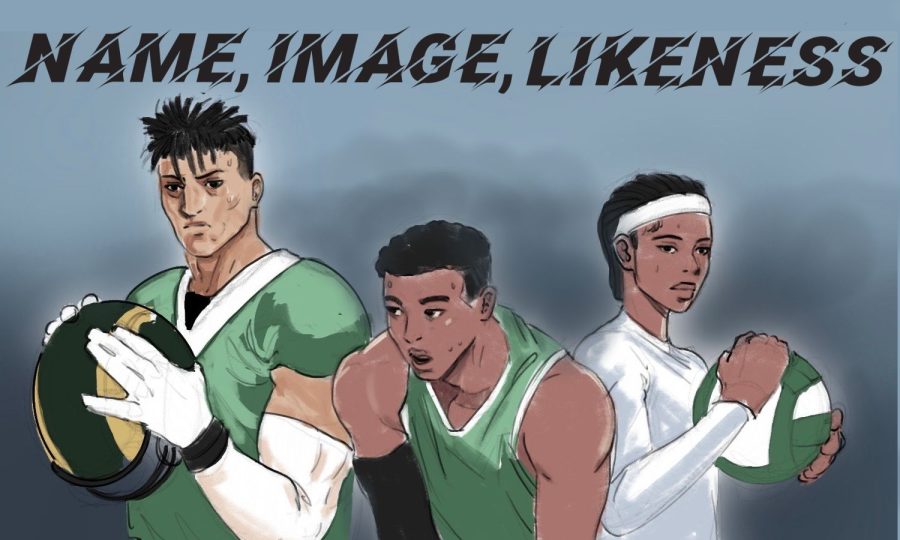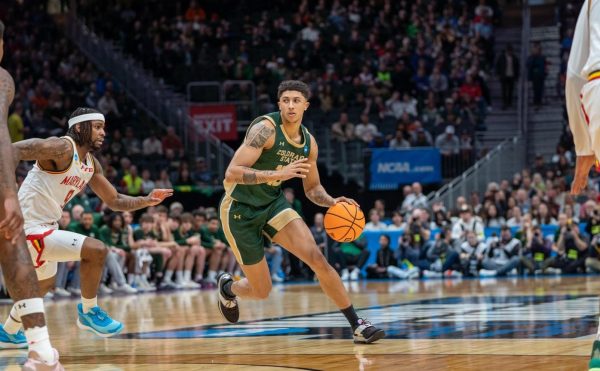Name, image, likeness: 7 months into the NIL era
February 10, 2022
On July 1, 2021, the college sports world was shaken up by a piece of legislation signed after years of debate. The NCAA eliminated restrictions against college athletes making money for their name, image and likeness — NIL for short.
Seven months later, athletes and programs all over the country have been taking advantage of the new rules. The University of Alabama quarterback Bryce Young, this year’s Heisman Trophy winner, has signed 14 NIL deals this season, totaling over an estimated $1 million.
New University of Texas at Austin quarterback Quinn Ewers signed a reported $1.4 million deal with GT Sports Marketing back in August 2021 to sign memorabilia. This was before ever taking a snap for The Ohio State University, where he played during the 2021 season before transferring to UT Austin. Two hundred and twenty athletes from OSU have signed a total of 608 NIL deals worth just under $3 million.
The Colorado State University NIL info page defines an NIL activity as “an activity that involves the use of an individual’s … name, image and likeness for commercial or promotional purposes.” Simply put, athletes can be paid for things like social media endorsements, content creation, special appearances, jersey sales and almost everything in between.
“There are a lot of opportunities out there, and we want to ensure our student-athletes approach each one thoughtfully and with the proper education.” -Joe Parker, CSU Athletics Director
“On day one, you saw a wave of student-athletes take advantage of new opportunities,” CSU Director of Athletics Joe Parker said. On that list of prospective business talent was none other than CSU basketball star forward David Roddy.
Roddy sent out a tweet on June 30 (the day the rule change was announced) that read, “Any local or any companies at all that want to use my social media as a platform to promote, do commercials, etc. to brand themselves, my (direct messages) are open for business. Message me if interested.”
Within a few weeks, Roddy had his first deal. Having a good friend at DNVR, a Denver sports-oriented media outlet, Roddy started to appear on podcasts, along with promoting DNVR gear through the podcast and on his social media platforms. Included in the deal was his own T-shirt affiliated with the DNVR brand.
Roddy’s next big deal was with the 1310 KFKA radio station in Greeley, Colorado, where he periodically co-hosts his own radio show, appropriately named the “David Roddy Show,” which is a section of radio host Brady Hull’s “The Hull Show.” Sponsored by Fort Collins-based Krazy Karl’s Pizza, Roddy appears once a week on a live radio show during which he and Hull talk about CSU basketball, Roddy’s personal life and much more.
“I’m on Zoom calls with CEOs and owners of companies, and I thought I would never do that in a million years,” Roddy said.
NIL has been a point of discussion for decades around the college athletics space. The longtime question has been whether college athletes, with their amateur status, should be compensated beyond scholarships they may or may not be getting. Since the passing of the new rules, the CSU Athletics department has sided with their student-athletes and their new opportunities.
“We have supported NIL legislation from the outset and will continue to support our student-athletes to engage in that space in the appropriate manner,” Parker said. “There are a lot of opportunities out there, and we want to ensure our student-athletes approach each one thoughtfully and with the proper education.”
Thus far, Roddy has emulated Parker’s hope of being thoughtful and knowledgeable about engaging in NIL activities. While some athletes could sign deal after deal without thinking about the outcomes, Roddy has taken a more measured approach in choosing what ventures he takes.
“First and foremost, it’s mostly what I would represent myself with,” Roddy said. “Understanding their mission statement and if that aligns with what I think of them and what I think of myself, that’s really where it usually starts.”
Roddy has also taken advantage of these NIL opportunities to learn more about himself and how to market himself as a person.
“It’s mostly just getting that experience, meeting new people and networking for later in life,” Roddy said, “and creating true relationships with people that can help down the line.”
In the first seven months of the NIL era, the opportunities and benefits provided to college athletes are seemingly endless and are not limited to solely financial help. Student-athletes like Roddy all over the country are learning how to market and express themselves as they navigate through college and into the professional world.
For athletes at the college level and beyond, the ball eventually stops rolling, and the hope for the NIL era is to give student-athletes the chance to continue their success once their playing days come to an end.
Reach Braidon Nourse at sports@collegian.com or on Twitter @BraidonNourse.






